Vietnam is considered one of the countries in Southeast Asia rich in biodiversity. Due to the significant climatic differences from the equatorial region to the subtropical zone, along with diverse topography, Vietnam boasts a high level of natural and biological diversity.
Despite significant losses in forest area over many centuries, the flora and fauna of Vietnam remain rich in species.
Currently, there are 275 species of mammals, 828 species of birds, 180 species of reptiles, 80 species of amphibians, 472 species of freshwater fish, approximately 2,000 species of marine fish, and tens of thousands of invertebrate species in terrestrial, marine, and freshwater environments.
The animal kingdom in Vietnam is not only rich in species composition but also has many unique characteristics, representing Southeast Asia with many endemic species.
Here are some images of representative species of the animal kingdom.
1. Wild Cattle
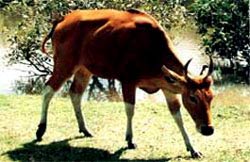 Their primary diet consists of grass and leaves. They breed from June to July, with a gestation period of 270 to 280 days, typically producing one calf per year.
Their primary diet consists of grass and leaves. They breed from June to July, with a gestation period of 270 to 280 days, typically producing one calf per year.
They prefer living in open, cool habitats, especially in dipterocarp forests. Their habitats are usually dense forests or valleys. Wild cattle live in herds of 10 to 30 individuals, exhibiting social behavior where they rest and sleep in a circular formation at night, with young and older individuals in the center and stronger young adults on the outside for protection. They feed during the day in the morning and late afternoon, resting and ruminating at noon.
Distribution:
– Vietnam: Previously found from Bien Hoa, Ba Ria to Phan Ri, Dak Rinh, Phan Thiet, Lam Dong, and La Nga River. Currently, they can be found from Kontum, Dak Lak (Dak Min, Easup) to Dong Nai (Nam Cat Tien), and Song Be (Bu Gia Map).
– Worldwide: Myanmar, Thailand, Indochina, Malaysia; Borneo, Sumatra, Java (Indonesia).
2. Banteng
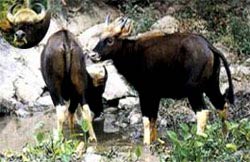 Banteng primarily feed on grass and leaves, bamboo shoots, and young plants. They breed from June to July with a gestation period of 270 to 280 days, producing one calf per year.
Banteng primarily feed on grass and leaves, bamboo shoots, and young plants. They breed from June to July with a gestation period of 270 to 280 days, producing one calf per year.
Bantengs inhabit evergreen rainforests, mixed forests, secondary forests, and dipterocarp forests, typically in relatively flat terrain at altitudes of 500 to 1,500 meters above sea level. They are active during the day in open forests, grasslands, and shrub areas, living in herds of 5 to 10 (sometimes 20 to 30 individuals), though solitary individuals can also be encountered.
Distribution:
– Vietnam: Lai Chau, Son La, Hoa Binh, Thanh Hoa, Nghe An, Ha Tinh, Quang Binh, Quang Nam – Da Nang, Gia Lai, Kom Tum, Dak Lak (Bao Loc), Dong Nai (La Nga, Vinh An, Nam Cat Tien), Song Be, Tay Ninh.
– Worldwide: Nepal, India, Myanmar, China, Thailand, Laos, Cambodia, Malaysia.
3. Clouded Leopard
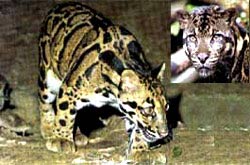 Clouded leopards primarily feed on small birds and mammals such as monkeys, langurs, civets, deer, and young ungulates. Their breeding season typically occurs in summer, with a gestation period of 90 to 95 days, producing 2 to 4 cubs per litter.
Clouded leopards primarily feed on small birds and mammals such as monkeys, langurs, civets, deer, and young ungulates. Their breeding season typically occurs in summer, with a gestation period of 90 to 95 days, producing 2 to 4 cubs per litter.
Clouded leopards inhabit multi-layered dense forests, both on land and rocky mountains. They use natural caves and hollows for nesting. They are nocturnal, excellent climbers, and catch prey from trees, usually sleeping on branches during the day.
– Vietnam: Tuyen Quang (Chiem Hoa), Lai Chau (Muong Te), Lang Son (Bac Son, Huu Lien), Son La (Thuan Chau, Bac Yen, Quynh Nhai, Song Ma), Vinh Phu (Thanh Son), Hoa Binh (Da Bac), Gia Lai, Kontum (Xa Thay, Kom Ha Nung).
– Worldwide: Nepal, India (Assam, Sikkim), Myanmar, southern China (Hainan), Taiwan, Indochina, Thailand, Malaysia; Borneo, Sumatra (Indonesia).
4. Leopard
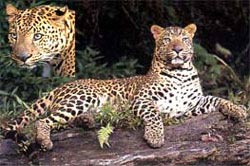 Their primary diet consists of other mammals such as deer, wild boars, monkeys, and livestock like buffalo, goats, and sheep. The breeding season is not distinctly marked. The gestation period is 94 to 98 days, with each litter producing 1 cub. They may give birth once a year or every three years.
Their primary diet consists of other mammals such as deer, wild boars, monkeys, and livestock like buffalo, goats, and sheep. The breeding season is not distinctly marked. The gestation period is 94 to 98 days, with each litter producing 1 cub. They may give birth once a year or every three years.
Leopards inhabit various types of forests, including primary and secondary forests, as well as shrublands adjacent to forests. They do not have fixed homes and can roam widely at different altitudes. They can climb trees that are 2 to 3 meters high. They live solitary lives, only pairing during mating season and forming temporary groups while hunting.
– Vietnam: Mountain provinces from North to South.
– Worldwide: Asia, Africa (excluding the Sahara Desert).
5. Fire Leopard
 Fire leopards primarily feed on small mammals such as rabbits, monkeys, young deer, civets, and various birds… They do not have a distinct breeding season. The gestation period is 95 days.
Fire leopards primarily feed on small mammals such as rabbits, monkeys, young deer, civets, and various birds… They do not have a distinct breeding season. The gestation period is 95 days.
Fire leopards inhabit various forest types, including mature forests, regenerating forests, shrublands, and areas adjacent to forests on both land and rocky mountains. Their preferred landscape is multi-layered forests with well-developed low layers and a leaf-covered ground. Fire leopards do not have long-term fixed homes, living solitary lives and nesting at the bases of trees or in rock cavities.
– Vietnam: Fire leopards are widely distributed in the mountainous provinces of the North and South.
– Worldwide: Nepal, India (Assam, Sikkim), Myanmar, southern China, Indochina, Thailand, Malaysia, Sumatra (Indonesia).
6. Gray Cattle
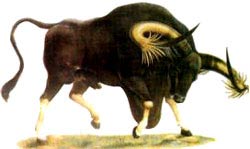 Gray cattle forage at the forest edges, primarily consuming grass, leaves from forest trees, and bamboo shoots. It has been observed that calves typically appear in December and January. The gestation period is 9 months, with one calf per year.
Gray cattle forage at the forest edges, primarily consuming grass, leaves from forest trees, and bamboo shoots. It has been observed that calves typically appear in December and January. The gestation period is 9 months, with one calf per year.
Gray cattle inhabit mature forests, sparse forests, and dipterocarp forests. They live in groups of 3 to 4, mingling with wild cattle, banteng, or forming herds of 4 to 20 individuals.
– Vietnam: Gia Lai, Kontum (Sa Thay), Dak Lak (Yok Don), Song Be (Bu Gia Map).
– Worldwide: Southeastern Thailand, Southern Laos, and northeastern Cambodia.
7. Brown-legged Macaque
Brown-legged macaques primarily feed on fruits, tender leaves, corn, sweet potatoes, cassava, and green vegetables from fields. They give birth once a year, with infants appearing in the spring to early summer.
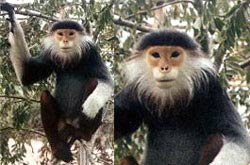 Brown-legged macaques inhabit mature forests and primary forests at altitudes of 500 to 1,000 meters above sea level. Their foraging areas also extend to secondary forests, open forests, and mixed forests in low mountain valleys and agricultural fields.
Brown-legged macaques inhabit mature forests and primary forests at altitudes of 500 to 1,000 meters above sea level. Their foraging areas also extend to secondary forests, open forests, and mixed forests in low mountain valleys and agricultural fields.
They live in troops of 5 to 10 individuals, with some groups containing 20 to 30 individuals. Each troop has a relatively separated home range from others. They are active during the day, especially in the morning and late afternoon, resting and sheltering in tall trees, on rocky ledges, or in rock cavities when it is cold.
– Vietnam: From Thanh Hoa (19°30′ N latitude) along the Truong Son mountain range to Gia Lai, Kontum, Dak Lak, Lam Dong, Dong Nai, Song Be, Tay Ninh.
– Worldwide: Hainan Island, Laos, Cambodia.
8. Wild Dog
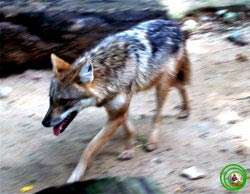 Wild dogs typically live in forest areas near fields, sometimes close to farms or human settlements within the forest. They may live alone or in pairs and forage at night. Unlike other wild canines, wild dogs are quite bold; they may enter human settlements in the forest at night to forage.
Wild dogs typically live in forest areas near fields, sometimes close to farms or human settlements within the forest. They may live alone or in pairs and forage at night. Unlike other wild canines, wild dogs are quite bold; they may enter human settlements in the forest at night to forage.
Their diet consists of small mammals, birds, reptiles, and amphibians. In Thailand, according to B. Lekagul (1988), wild dogs often follow tigers to eat leftover meat.
Distribution: This species is found across Europe, Asia, and Africa. In Vietnam, it has been observed in the Central Highlands (Gia Lai, Kontum). It was first discovered in Dak Lak.
9. Red Wolf
Red wolves primarily feed on deer, wild boars, livestock, and large birds. They breed almost year-round, with the peak breeding months being November to February. The gestation period is approximately 9 weeks, with each litter containing 4 to 6 pups, sometimes up to 10 or 11.
 They inhabit forests, usually residing and hunting in mature forests but may approach human settlements while hunting. Red wolves are nocturnal but are most active in the early morning and late evening (sometimes even during the day), covering large and constantly changing territories. They may live in pairs or in packs of 5 to 7, sometimes forming larger groups of 10 to 15 during hunts.
They inhabit forests, usually residing and hunting in mature forests but may approach human settlements while hunting. Red wolves are nocturnal but are most active in the early morning and late evening (sometimes even during the day), covering large and constantly changing territories. They may live in pairs or in packs of 5 to 7, sometimes forming larger groups of 10 to 15 during hunts.
– Vietnam: Lai Chau, Lao Cai (Sapa), Bac Thai, Son La (Moc Chau), Gia Lai, Kom Tum, Dak Lak. Red wolves are widely distributed in mountainous provinces.
– Worldwide: Former Soviet Union, Nepal, India, Myanmar, China, North Korea, Thailand, Laos, Cambodia, Malaysia, Sumatra, Java, Indonesia.
10. Southern Chevrotain
Their primary diet consists of fruits and leaves. The breeding season lasts from January to May, with a gestation period of 130 to 150 days, producing one offspring per year.
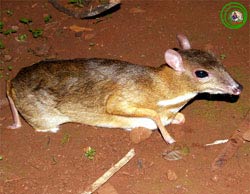 Habitat and Ecology:
Habitat and Ecology:
They inhabit mature forests and open forests with dense foliage in relatively flat terrain. Their shelters are typically found at the bases of large trees or shrubs. They only mate during the breeding season and are primarily nocturnal.
– Vietnam: Lạng Sơn (Yên Bình, Hữu Lũng), Vĩnh Phú (Tam Đảo), Thanh Hóa (Thường Xuân, Hồi Xuân), Nghệ An (Quỳ Châu, Phủ Quỳ), Hà Tĩnh (Hương Khê), Quảng Trị, Quảng Bình, Thừa Thiên – Huế, Gia Lai, Kom Tum, Đắc Lắc, Lâm Đồng, Tây Ninh, Sông Bé, Đồng Nai (La Ngà, Vĩnh An).
– Worldwide: India, Thailand, Laos, Cambodia; Borneo, Sumatra, Java (Indonesia).
11. Cheo Cheo Napu
Their main food consists of leaves and grass. The breeding season is not clearly defined. The gestation period is 152 – 172 days. They give birth to one litter each year, with one offspring per litter.
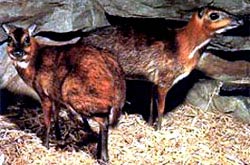 Cheo Cheo Napu lives in old forests and sparse forests on relatively flat mountainous terrain. They are likely not adapted to high mountainous areas. They are solitary, quiet, and only pair during the mating season.
Cheo Cheo Napu lives in old forests and sparse forests on relatively flat mountainous terrain. They are likely not adapted to high mountainous areas. They are solitary, quiet, and only pair during the mating season.
– Vietnam: Khánh Hòa (Nha Trang). According to a survey conducted in 1983, they may still be found in Quảng Nam – Đà Nẵng, Phú Yên, and Quảng Ngãi.
– Worldwide: Thailand, Indochina, Malaysia; Borneo, Sumatra, Java (Indonesia).


















































